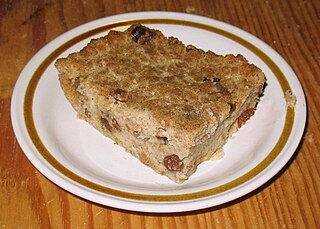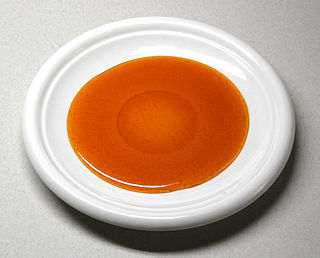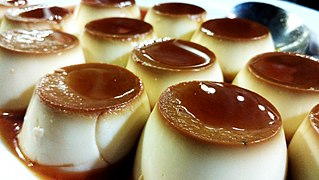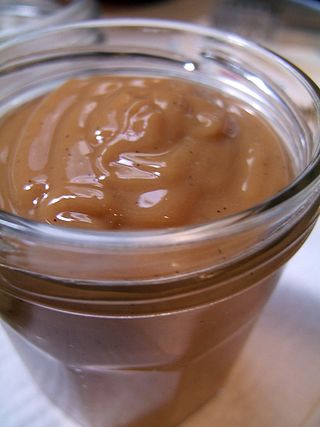
Dessert is a course that concludes a meal. The course consists of sweet foods, such as cake, biscuit, ice cream and possibly a beverage such as dessert wine and liqueur. Some cultures sweeten foods that are more commonly savory to create desserts. In some parts of the world there is no tradition of a dessert course to conclude a meal.

Bread pudding is a bread-based dessert popular in many countries' cuisines. It is made with stale bread and milk or cream, generally containing eggs, a form of fat such as oil, butter or suet and, depending on whether the pudding is sweet or savory, a variety of other ingredients. Sweet bread puddings may use sugar, syrup, honey, dried fruit, nuts, as well as spices such as cinnamon, nutmeg, mace, or vanilla. The bread is soaked in the liquids, mixed with the other ingredients, and baked.

Caramel is an orange-brown confectionery product made by heating a range of sugars. It can be used as a flavoring in puddings and desserts, as a filling in bonbons or candy bars, or as a topping for ice cream and custard.

Crème caramel, flan, caramel pudding, condensed milk pudding or caramel custard is a custard dessert with a layer of clear caramel sauce.

Dulce de leche, caramelized milk, manjar, milk candy or milk jam is a confection popular in Latin America, France, Poland and the Philippines prepared by slowly heating sugar and milk over a period of several hours. The resulting substance, which takes on a spreadable, sauce-like consistency, derives its rich flavour and colour from non-enzymatic browning. It is typically used to top or fill other sweet foods.

Rice pudding is a dish made from rice mixed with water or milk and commonly other ingredients such as sweeteners, spices, flavourings and sometimes eggs.
Crusha is a brand of milkshake mix, sold in the United Kingdom. The brand first appeared in 1955, and was bought by British Sugar. In December 2001, it came under the Silver Spoon brand. Crusha is often the milkshake of choice in cafés. However, it is also sold in shops, for home mixing in bottles, of from 250ml to 1l in size.

Banoffee pie is a British dessert pie made from bananas, whipped cream, and a thick caramel sauce, combined either on a buttery biscuit base or one made from crumbled biscuits and butter. Some versions of the recipe include chocolate, coffee, or both.

Chocolate cake or chocolate gâteau is a cake flavored with melted chocolate, cocoa powder, or both. It can also have other ingredients such as fudge, vanilla creme, and other sweeteners.

Sticky toffee pudding, known as sticky date pudding in Australia and New Zealand, is a British dessert consisting of a moist sponge cake made with finely chopped dates (optional), covered in a toffee sauce and often served with a vanilla custard or vanilla ice-cream. It is considered a British classic by various culinary experts.

An icebox cake is a dairy-based dessert made with cream, fruits, nuts, and wafers and set in the refrigerator. One particularly well-known version used to be printed on the back of boxes of thin and dark Nabisco Famous Chocolate Wafers.

Dobos torte, also known as Dobosh, is a Hungarian sponge cake layered with chocolate buttercream and topped with caramel. The layered pastry is named after its inventor, Hungarian chef József C. Dobos, a delicatessen owner in Budapest. In the late 1800s, he decided to create a cake that would last longer than other pastries in an age when cooling techniques were limited. The round sides of the cake are coated with ground hazelnuts, chestnuts, walnuts, or almonds, and the hardened caramel top helps to prevent drying out, for a longer shelf life.

Dessert bars or simply bars or squares are a type of American "bar cookie" that has the texture of a firm cake or softer than usual cookie. They are prepared in a pan and then baked in the oven. They are cut into squares or rectangles. They are staples of bake sales and are often made for birthdays. They are especially popular during the holidays, but many people eat them all year. Many coffee shops and bakeries also offer the treats. Popular flavors include peanut butter bars, lemon bars, chocolate coconut bars, pineapple bars, apple bars, almond bars, toffee bars, chocolate cheesecake bars and the "famous" seven-layer bar. In addition to sugar, eggs, butter, flour and milk, common ingredients are chocolate chips, nuts, raspberry jam, coconut, cocoa powder, graham cracker, pudding, mini-marshmallows and peanut butter. More exotic bars can be made with ingredients including sour cream, rhubarb, pretzels, candies, vanilla, raisins, and pumpkin. The Nanaimo bar is a bar dessert that requires no baking and is named after the city of Nanaimo, British Columbia.

Sponge cake is a light cake made with eggs, flour and sugar, sometimes leavened with baking powder. Some sponge cakes do not contain egg yolks, like angel food cake, but most of them do. Sponge cakes, leavened with beaten eggs, originated during the Renaissance, possibly in Spain. The sponge cake is thought to be one of the first non-yeasted cakes, and the earliest attested sponge cake recipe in English is found in a book by the English poet Gervase Markham, The English Huswife, Containing the Inward and Outward Virtues Which Ought to Be in a Complete Woman (1615). Still, the cake was much more like a cracker: thin and crispy. Sponge cakes became the cake recognised today when bakers started using beaten eggs as a rising agent in the mid-18th century. The Victorian creation of baking powder by English food manufacturer Alfred Bird in 1843 allowed the addition of butter to the traditional sponge recipe, resulting in the creation of the Victoria sponge. Cakes are available in many flavours and have many recipes as well. Sponge cakes have become snack cakes via the Twinkie.

Instant pudding is an instant food product that is manufactured in a powder form and used to create puddings and pie filling. It is produced using sugar, flavoring agents and thickeners as primary ingredients. Instant pudding can be used in some baked goods.

Muhallebi is a milk pudding commonly made with rice, sugar, milk and either rice flour, starch or semolina, popular as a dessert in the Turkey and Middle East. While the dessert is called Muhallebi in Turkey and Iraq, the Egyptian variant is called mahalabia, the levantine variant is called mahalabiyeh.
Pie in American cuisine has roots in English cuisine and has evolved over centuries to adapt to American cultural tastes and ingredients. The creation of flaky pie crust shortened with lard is credited to American innovation.
















